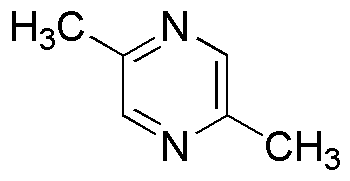2,5-Dimethylpyrazine is widely utilized in research focused on:
- Food Flavoring: This compound is commonly used in the food industry to enhance the flavor profile of various products, particularly in savory snacks and sauces, providing a roasted, nutty aroma that appeals to consumers.
- Aromatic Compounds: In the fragrance industry, it serves as a key ingredient in perfumes and scented products, contributing to complex scent formulations that are both appealing and distinctive.
- Pharmaceuticals: It is explored in medicinal chemistry for its potential therapeutic effects, particularly in developing new drugs that target specific biological pathways.
- Research Applications: In academic and industrial research, it is used as a model compound to study reaction mechanisms and the behavior of similar nitrogen-containing compounds, aiding in the development of new materials.
- Agrochemicals: The compound is investigated for its potential use in agrochemical formulations, where it may enhance the efficacy of pesticides or fertilizers, contributing to more sustainable agricultural practices.
General Information
Properties
Safety and Regulations
Applications
2,5-Dimethylpyrazine is widely utilized in research focused on:
- Food Flavoring: This compound is commonly used in the food industry to enhance the flavor profile of various products, particularly in savory snacks and sauces, providing a roasted, nutty aroma that appeals to consumers.
- Aromatic Compounds: In the fragrance industry, it serves as a key ingredient in perfumes and scented products, contributing to complex scent formulations that are both appealing and distinctive.
- Pharmaceuticals: It is explored in medicinal chemistry for its potential therapeutic effects, particularly in developing new drugs that target specific biological pathways.
- Research Applications: In academic and industrial research, it is used as a model compound to study reaction mechanisms and the behavior of similar nitrogen-containing compounds, aiding in the development of new materials.
- Agrochemicals: The compound is investigated for its potential use in agrochemical formulations, where it may enhance the efficacy of pesticides or fertilizers, contributing to more sustainable agricultural practices.
Documents
Safety Data Sheets (SDS)
The SDS provides comprehensive safety information on handling, storage, and disposal of the product.
Product Specification (PS)
The PS provides a comprehensive breakdown of the product’s properties, including chemical composition, physical state, purity, and storage requirements. It also details acceptable quality ranges and the product's intended applications.
Certificates of Analysis (COA)
Search for Certificates of Analysis (COA) by entering the products Lot Number. Lot and Batch Numbers can be found on a product’s label following the words ‘Lot’ or ‘Batch’.
Numéro de catalogue
Numéro de lot/série
Certificates Of Origin (COO)
This COO confirms the country where the product was manufactured, and also details the materials and components used in it and whether it is derived from natural, synthetic, or other specific sources. This certificate may be required for customs, trade, and regulatory compliance.
Numéro de catalogue
Numéro de lot/série
Safety Data Sheets (SDS)
The SDS provides comprehensive safety information on handling, storage, and disposal of the product.
DownloadProduct Specification (PS)
The PS provides a comprehensive breakdown of the product’s properties, including chemical composition, physical state, purity, and storage requirements. It also details acceptable quality ranges and the product's intended applications.
DownloadCertificates of Analysis (COA)
Search for Certificates of Analysis (COA) by entering the products Lot Number. Lot and Batch Numbers can be found on a product’s label following the words ‘Lot’ or ‘Batch’.
Numéro de catalogue
Numéro de lot/série
Certificates Of Origin (COO)
This COO confirms the country where the product was manufactured, and also details the materials and components used in it and whether it is derived from natural, synthetic, or other specific sources. This certificate may be required for customs, trade, and regulatory compliance.


